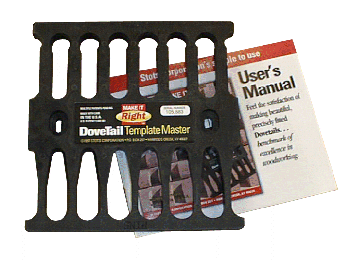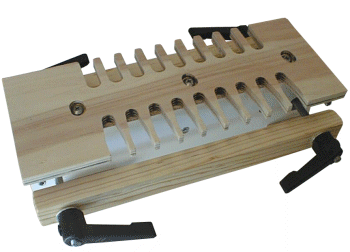|
|
|
| Description
The Stots Dovetail Template Master is a somewhat unusual accessory. Most woodworking accessories are used to cut, measure, position, clamp, or otherwise perform some direct woodworking task. The Dovetail Template Master is actually a tool designed to help MAKE a woodworking accessory. The Dovetail Template Master is quite simple, it consists of a plastic template and a set of instructions - that's it. In order to use the device you will need to supply some material and a method to create the templates, this would most often be a few pieces of MDF and a router with a straight bit and bearing. |
 |
| Although it would be
possible to use the template to build a dovetail jig itself, that is not it's intended
function. The function of the template is to use it to produce exact copies of itself;
these copies become the actual tool. Why would you want to do that? One popular method of cutting dovetails is to use a router and template system. There are several dovetail jigs on the market; all of these jigs in one way or another attempt to provide for very precise positioning of the cutter; that IS the name of the game with these tools. This is necessary because of the very tight tolerances required of a good fitting dovetail joint. An error of only a few thousandths of an inch will produce noticeable gaps, sloppy fit, or even prevent the joint from coming together at all. Making A Jig The instructions are well illustrated and straightforward. They clearly show how to make two different styles of jigs as well as how to align them. The process for building a jig is so easy in fact that everything you really need to know is printed right on the box it comes in. The manual does provide more (important) detail though. In addition to the printed manual a tutorial video is available on a CD. I found the video to be quite clear and of better than average quality and usefulness. Presented in the video are several very good tips for building and using the system. Using the master template one can easily make work templates of any length with joint spacing on any multiple of one inch. With more effort a spacing other than one inch multiples can also be made. Unless you were to get fancy in constructing your jig, It is probably going to end up looking very much like a few other commercial jigs, notably the Gifkins, Katie, or Keller types. You are not limited to this format though. Using The Jig I'm of the opinion that the fixed template / bearing guided jigs are the easiest to use of all the dovetail jigs. The completed jig can be used in either a router table or with a free-hand router. For small pieces the router table method is probably a little better especially if the jig isn't too wide. For larger case-sized stock a free-hand router will be the preferred method. Once the stock is clamped to the jig creating a joint is just a simple matter of running the cutter against the pattern. As with all dovetail jigs consistent thickness, flat, and square stock is desirable for the best results. Although the Stots-made jig is a Through Dovetail (TD) type of jig it is possible to do Half Blind (HB) joints as well. Basically this is done by applying a false front. The maker claims this is an easier and more preferable method than creating HB joints on a jig and although this may be "woodworking heresy" I actually agree with this. I will say this also, this technique creates a far better looking joint than what you get using the common "cookie cutter" HB jigs. Tips I do have a few simple tips for making and using the Stots Dovetail Template Master that I want to pass along: 1. When cutting the comb pattern I recommend taking extra care so as to not damage the master template as well as taking the time to be very meticulous in the creation of the jig(s). The master template is right-on and you want to ensure that the templates you make from it are as true to the original as possible. 2. The instructions mention drilling starter holes and then plowing out the rest of the pattern. I recommend instead cutting away as much waste material as possible with a saw. 3. Although you can use the template to make a very fancy jig I recommend not doing that at least at first. I recommend building what is described in the instructions and if you find those designs limiting later you can improve upon them as you see fit. 4. Like many dovetail jigs, you may discover that you can get quite a bit of chipout on the front where the cutter enters. You can greatly reduce if not totally eliminate this by using a "fronter" board. 5. When cutting joints, run the router on a high speed setting. Summary In the interest of full disclosure Stots provided this product to facilitate this review.
For more a more advanced article on making and using the Stots system, click here. |
|
| This is one example of a completed
dovetail jig. It is made in a form similar to the Keller Journeyman with the
addition of clamping bars and positioning stops. This particular example has about
eight inches of capacity. The comb or template is made of 1/2" Poplar plywood, it is attached to the backer section of the jig using 1/4-20 screws; it is removable as well as micro-adjustable. |
 |